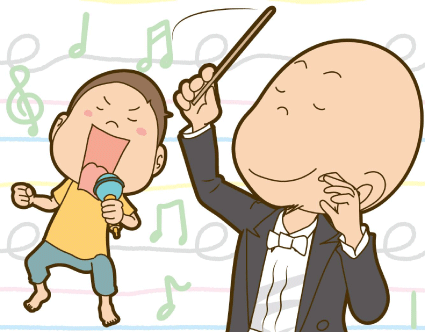Table of Contents
- Parenting cartoon “Let’s Play at Home”
- Concert with things from home! Let’s have fun with Dad and sound!
Parenting cartoon “Let’s Play at Home”
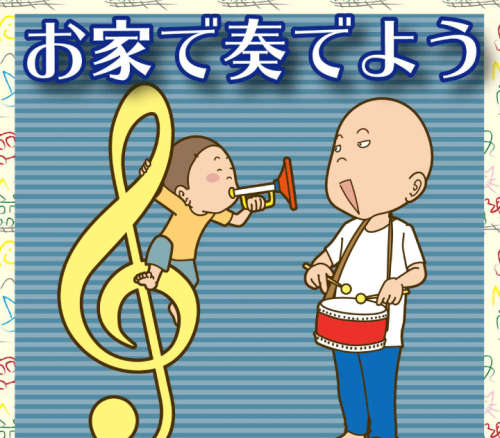
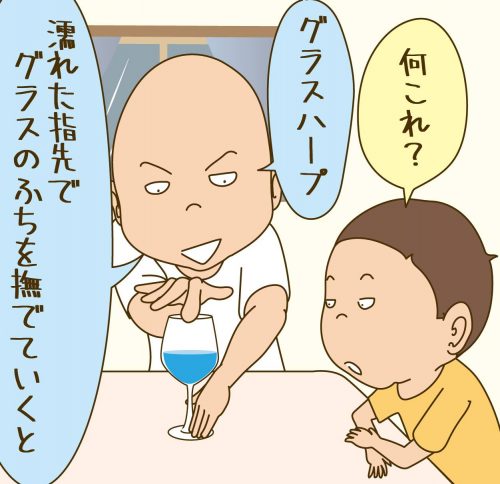
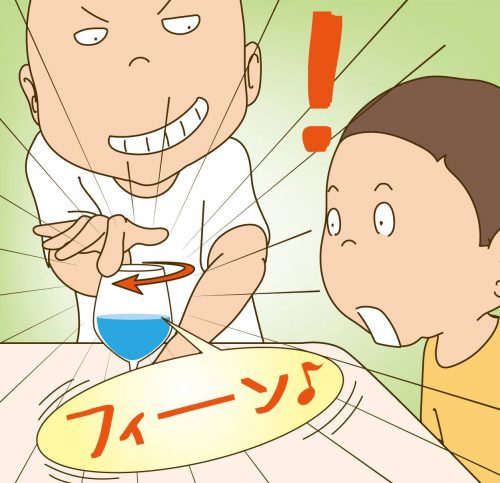
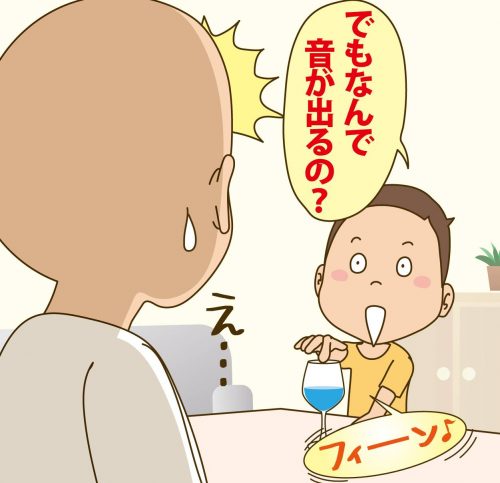


Profile
Eiichi
After working for a design company in Tokyo, he became a freelance illustrator. He is a hard-working father who creates animation, manga, and illustrations, including winning the Yubari International Fantastic Film Festival’s International Short Film Showcase Division Excellence in Animation Award.
Concert with things from home! Let’s have fun with Dad and sound!
In the wake of the new coronavirus outbreak,
Many families have more time to spend with their children at home.
It is not only passively enjoyed on TV or video streaming services,
Learning through play where children actively act on their own,
Many fathers would like to see them grow up.
So this time,
The theme is fun sound play that you can do at home,
From the experts
How to interact with music and children and how to enjoy sound with musical instruments
He talked about how to play with hands and fingers in time with songs.
Communicate with children through music!
Syoyo Kajikawa researches and teaches at Tamagawa University’s College of Liberal Arts about human characteristics of communication through speech, including language and music, and about children and music. We asked him about the major theme of how music affects children, as well as some pointers on how to interact with children through music.
The Role of Song in Controlling Children’s Emotions
There are many types of music, and research has shown that singing, in particular, helps control children’s emotions. Singing is also an easy method of communication that does not require a specific place, object, or time, making it easy for anyone to adopt and influence a child’s development.
When parents sing lullabies and nursery rhymes, children feel calmed and reassured by melodies and voices they have heard before. The reaffirmation of what they know seems to induce feelings of joy. When parents also see their children relieved and enjoying themselves, it brings them joy, a recognition that they are involved, a sense of togetherness and bonding, and an opportunity for satisfaction.
Rather than talking to them, you may want to incorporate the songs into your communication with your children because the tempo and phrasing are consistent, and the songs are familiar and children respond well to them.
In addition, dancing to a song is even more effective, as studies have shown that when children as young as one year old and adults dance together for a certain period of time, a sense of camaraderie develops among the children, and even those who have never met before easily become less guarded and show signs of wanting to help.
Types of sounds and children’s reactions
It has been shown that children’s responses to songs and sounds can vary depending on the type of song or sound being played.
For example, when a child is in a good mood, slow, leisurely music can make him or her sleepy. Even a child who is only a few months old already has an excellent ability to sense feelings from music, and this kind of change in behavior can be observed. They can also understand emotional expressions such as low voice means they are angry and high voice means they are happy.
However, I don’t think it has much to do with whether or not they can develop musical talent or acquire abilities, such as singing well enough to become a professional singer or having an excellent sense of rhythm, just because they are exposed to a lot of music until they are about 6 years old, when they can understand pitch. (Laughter)
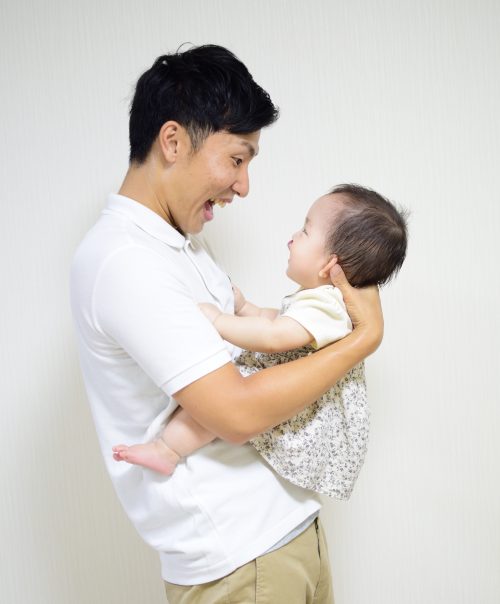
Age and how music interacts
Changes in a child’s state of health can be seen when singing to the child as early as 3 months of age. When a parent sings to a child who is looking away, there is a clear difference in response, such as vocalization and flapping of arms and legs.
At 1-2 years old, children learn what kind of music they like, and their eyes light up and they respond actively to different songs; at 3-5 years old, they gradually learn rhythm and begin to sing along with their own voice and the voices around them; at 6 years old and beyond, they are able to reach pitch; at 6 years old, they are able to sing in tune; at 7 years old, they are able to sing in a more natural way; at 8 years old, they are able to sing in a more natural way. While it is necessary for parents to sing to their children unilaterally, it is also important for children to experience a sense of fun by changing the way they move and sing according to their reactions.
When parents have fun, kids have fun.
Rather than trying to communicate or please your child, it is better to share the music that you prefer and enjoy with your child, so that he or she can enjoy it as well. We encourage you to enjoy the fun of searching for your child’s comfort, like experimenting to see if he or she remembers the song you played yesterday, or whether he or she is more pleased with vertical or horizontal rocking.
Let’s make a musical instrument from something familiar!
Ms. Minami Amemiya of Kids Color Co., Ltd. manages “HoiClue,” a website that provides information and ideas for “play” and “learning” to expand childcare and child-rearing. She started the website 10 years ago after realizing as a childcare worker that it was important to constantly input knowledge and experience in order to spend time next to children who are growing day by day, and to grow herself. We asked her about the values she has developed through interviewing many people, and intertwined them with the theme of music and playing musical instruments.

Enjoying Familiar Sounds
Our daily lives are filled with various sounds. Trees rustling in the wind, trains passing by, dishes clanking on top of each other, toys colliding with toys, clapping hands… “Let’s touch music! Let’s sing a song!” If you try to enjoy “sound” in your daily life, you will discover many things, not only for children, but also for adults.
Valuing the child’s “I want to try it!
We can also make our own musical instruments that make “sound”. For example, maracas are easy for small children to enjoy.
Simply put beads, cut straws, rice, adzuki beans, acorns, etc. in a small plastic bottle or lactobacillus drink container and close the lid so you can enjoy it at home. (*Please be careful not to accidentally ingest the beads. Wrap a piece of plastic tape around the lid for safety.)
Since the sound varies depending on the material used and the amount of material used, it is interesting to try making different kinds, or if you are making them with children, it is interesting to experiment to see what kind of sound they make and how much you put in.
In addition, there is an original musical instrument made of a single cardboard board with a device that makes various sounds, which the children enjoyed very much. The instruments can be rubbed, tapped, or flipped, and different sounds can be made by different combinations of objects, allowing visitors to experience the mechanism and wonder of sound.
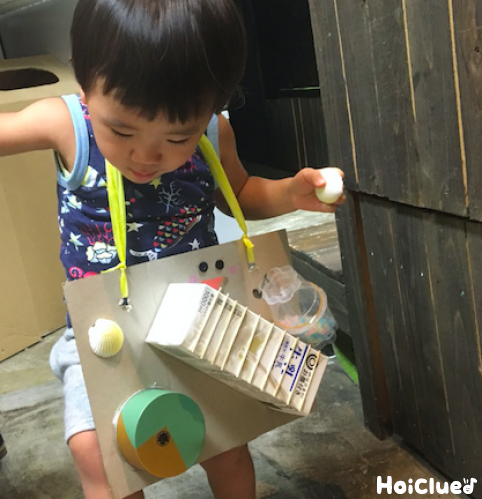
Guitars, which can be made from familiar materials, are another popular handmade musical instrument for children. It would be fun to make various instruments from scrap wood and have a session with them.
Materials are foam trays, cardboard, colored paper, and rubber bands. Tools are scissors, glue, duct tape, crayons for coloring, and markers. Simply attach the colored paper to the tray, make a cut, hook a rubber band, and make a neck out of cardboard and attach it. You can easily make an original guitar.
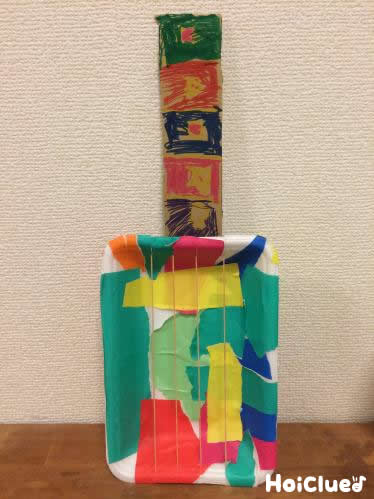
Depending on the age of the children, their interests and timing, they will have different ways to enjoy and develop an interest in “sound” and music. Perhaps a play that an adult thinks “sounds fun,” or “I want to let her play it,” may be something that a child “wants to try! I want to let them try it,” may not be the same as “I want to try it! It may not always be what the child is interested in. I believe that both adults and children can have fun without any difficulty if we take into consideration the fact that children may not always be interested in the activity, and if we keep in mind that we should enjoy it when the timing is right for them to be interested in it.
Let’s play with children with hand play songs!
While working as a nursery school teacher for eight years, Sho Fukuda became immersed in the joy of creating original play songs as a hobby, and has now quit her job as a nursery school teacher to work as a play song writer. We spoke with a father, a nursery school teacher, and a composer about how to interact with hand-play songs and children from three different perspectives.
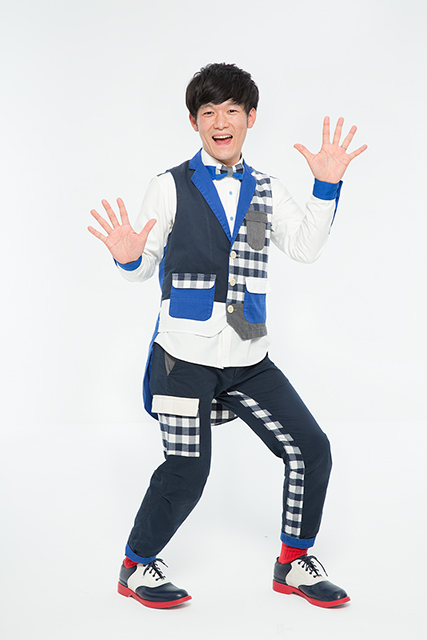
A child who likes to sing and play
Play songs of all kinds, including hand games, are said to be an excellent way to build trust between children and their parents. When children feel trusted and secure with adults, they are more willing to try new things. We hope that you will incorporate many songs into your home to build a good relationship with your children.
The way children enjoy singing and playing depends on their development. In the infant stage, when fingers do not move easily, hand play songs are more like a way for parents to convey the fun rather than a way to enjoy the songs together. Many people have tried to entertain their children with one hand while holding them in their arms; at 1~2 years old, children can enjoy singing while bending their fingers, and as they get older, they can enjoy singing and playing with their whole bodies.

What kinds of hand play songs are there?
Although there are quite a few types of hand play songs, such as waraben and nursery rhymes, given their history, there are three main types of play using songs.
There are “interaction play,” in which adults sing while interacting with children, “hand play,” in which children move their fingertips and play with their hands, and “expressive play,” in which children link words and body movements with each other, as well as gymnastics and dance. Depending on the child’s development, a single song can be used for either interaction or expressive play, so it is important to have fun while satisfying the child’s self-esteem, regardless of the type.
Dad’s Fun
When dads play hand games with their children, they can make the children more entertained by moving their entire bodies in a big way. By moving his body in a big way, the child thinks that dad is having fun and is happy to be connected with him.

In “Haunted Town,” which I composed, the children feel more enjoyment by using their whole body in addition to playing with their hands.
While early education is a focus and a lot of learning is necessary during infancy, it is also a time when bonding and trust can easily be fostered. It is also necessary for parents and children to experience self-affirmation by performing play songs together.

There are many ways to enjoy sound, but all are considered very effective as a means of communication between children and their parents. In addition, sound can be enjoyed simply by being aware of everyday objects and things, and singing and playing with musical instruments can be easily done anytime, anywhere, and at any time. Why don’t you try to find ways to interact with sound as your child grows up, while enjoying yourself, within your own reasonable limits?




